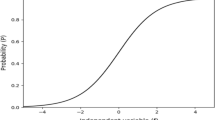Abstract
Identification of nuclear pulse signal is of importance in radioactive measurements, especially in recognizing adjacent overlapping nuclear pulses. In this article, we propose an estimation method for parameters of typical overlapping nuclear pulse signals. First, the nuclear pulses are regarded as individual genes and the norm is set as the fitness function. Second, the global optimal solution is found by searching the population of genetic algorithm, so as to estimate the parameters of nuclear pulse. With high precision, this method can identify parameters of overlapping nuclear pulses in the Sallen–Key Gaussian signal decomposition experiments. This pulse recognition method is of great significance to improve the precision of radioactive measurement and is suitable for serious overlap of nuclear pluses.









Similar content being viewed by others
References
Z.Y. Wang, B.Q. Lou, J.J. Zhu et al., Principle of Nuclear Electronics (Atomic Energy Press, Beijing, 1989), pp. 75–99. (in Chinese)
J.J. Wang, T.M. Fan, Y.K. Qian, Nuclear Electronics (Atomic Energy Press, Beijing, 1983), pp. 135–199. (in Chinese)
L.J. Xu, Signal and System (Peking University Press, Beijing, 2013), pp. 200–230. (in Chinese)
J. Lanchares, O. Garnica, L. José, J. Risco-Martín, I. Hidalgo, A. Regadío, Real-time evolvable pulse shaper for radiation measurements. Nucl. Instrum. Methods A 727, 73–83 (2013). doi:10.1016/j.nima.2013.05.164
V.T. Jordanov, Exponential signal synthesis in digital pulse processing. Nucl. Instrum. Methods A 670, 18–24 (2012). doi:10.1016/j.nima.2011.12.042
D.C. Li, L. Yang, Y. Tian et al., A random multi-mode signal generator of imitated nuclear radiation pulse. J. Lanzhou Univ. (Nat Sci.) 43, 110–113 (2007). doi:10.13885/j.issn.0455-2059.2007.03.023
N. Menaa, P. D’Agostino, B. Zakrzewski, V.T. Jordanov, Evaluation of real-time digital pulse shapers with various HPGe and silicon radiation detectors. Nucl. Instrum. Methods A 652(1), 512–515 (2010). doi:10.1016/j.nima.2010.08.095
G. Gerardi, L. Abbene, A.L. Manna et al., Digital filtering and analysis for a semiconductor X-ray detector data acquisition. Nucl. Instrum. Methods A 571(1), 378–380 (2007). doi:10.1016/j.nima.2006.10.113
V.T. Jordanov, Real time digital pulse shaper with variable weighting function. Nucl. Instrum. Methods A 505(1), 347–351 (2003). doi:10.1016/S0168-9002(03)01094-5
P. O’Connor, G. Gramegna, P. Rehak, F. Corsi, C. Marzocca, Ultra low noise CMOS preamplifier-shaper for X-ray spectroscopy. Nucl. Instrum. Methods A 409(1), 315–321 (1998). doi:10.1016/S0168-9002(97)01289-8
T. Trigano, A. Souloumiac, T. Montagu et al., Statistical pileup correction method for HPGe detectors. IEEE Trans. Signal Process. 55(10), 4871–4881 (2007). doi:10.1109/TSP.2007.896300
T. Trigano, I. Gildin, Y. Sepulcre, Pileup correction algorithm using an iterated sparse reconstruction method. IEEE Signal Process. Lett. 22(9), 1392–1395 (2015). doi:10.1109/LSP.2015.2406911
Y. Sepulcre, T. Trigano, Y. Ritov, Sparse regression algorithm for activity estimation in γspectrometry. IEEE Trans. Signal Process. 61(17), 4347–4359 (2013). doi:10.1109/TSP.2013.2264811
E. Gatti, A. Geraci, G. Ripamonti, Optimum filter for 1 f current noise smoothed-to-white at low frequency. Nucl. Instrum. Methods A 394(1), 268–270 (1997). doi:10.1016/S0168-9002(97)00593-7
S.G. Chen, S.Y. Ji, W.S. Liu et al., Recursive implementation of Gaussian pulse shaping based on wavelet analysis. Acta Phys. Sin. 58, 3041–3046 (2009). (in Chinese)
E. Gatti, A. Geraci, G. Ripamonti, Automatic synthesis of optimum filters with arbitrary constraints and noises: a new method. Nucl. Instrum. Methods A 381(1), 117–127 (1996). doi:10.1016/0168-9002(96)00653-5
A. Geraci, E. Gatti, Optimum filters for charge measurements in the presence of 1/f current noise. Nucl. Instrum. Methods A 361(1), 277–289 (1995). doi:10.1016/0168-9002(95)00214-6
J.B. Zhou, W. Zhou, J.R. Lei et al., Study of time-domain digital pulse shaping algorithms for nuclear signals. Nucl. Instrum. Methods 23, 150–155 (2012)
Author information
Authors and Affiliations
Corresponding author
Additional information
This work was supported by the National Natural Science Foundation of China (No. 41204133); Sichuan Province Science and Technology Support Program (No. 2014GZ0020); the Open Science Fund from Key Laboratory of Radioactive Geology and Exploration Technology Fundamental Science for National Defense, East China Institute of Technology(No. RGET1401); and Scientific Research Fund of Sichuan Provincial Education Department (No. 13ZA0066).
Rights and permissions
About this article
Cite this article
Huang, HQ., Yang, XF., Ding, WC. et al. Estimation method for parameters of overlapping nuclear pulse signal. NUCL SCI TECH 28, 12 (2017). https://doi.org/10.1007/s41365-016-0161-z
Received:
Revised:
Accepted:
Published:
DOI: https://doi.org/10.1007/s41365-016-0161-z




